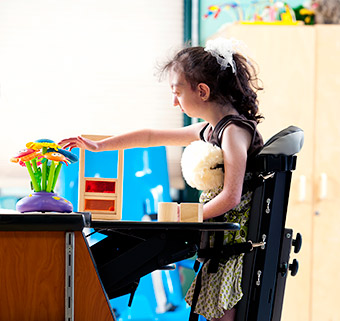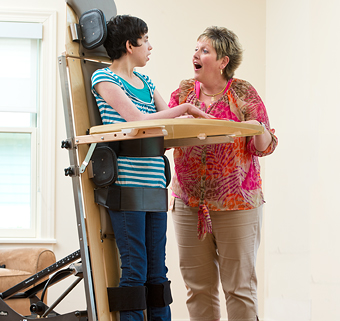Navigating the Funding Maze for Assistive Technology
Tips for Avoiding Bumps in the Road
| August 2022 Assistive technology includes a range of devices that help people with disabilities increase, maintain or improve their functional abilities such as seeing, hearing, walking/mobility, verbal and written communication and learning. Devices also vary in terms of price and complexity. Funding for assistive technology, including adaptive positioning equipment, can be complex and cumbersome for individuals with disabilities and their families and the therapists who are often assisting them with securing equipment to meet their needs. Having background information and developing a strategy, in advance, can save time and effort and may help avoid denials and lengthy appeals.
Assistive technology includes a range of devices that help people with disabilities increase, maintain or improve their functional abilities such as seeing, hearing, walking/mobility, verbal and written communication and learning. Devices also vary in terms of price and complexity. Funding for assistive technology, including adaptive positioning equipment, can be complex and cumbersome for individuals with disabilities and their families and the therapists who are often assisting them with securing equipment to meet their needs. Having background information and developing a strategy, in advance, can save time and effort and may help avoid denials and lengthy appeals.
Positioning equipment is necessary for individuals who are unable to support themselves while sitting, standing, or lying down. Examples of positioning equipment include but are not limited to: bolsters, pillows, wedges, standing frames, side lyers, seating systems, specialized seat and back cushions, toilet chairs and bath/shower chairs. Some positioning equipment is free-standing while others may be incorporated into a mobility device such as a manual or power wheelchair or mobile standing frame.
Know Your Funding Source
Part of the challenge with securing funding for positioning equipment is that funding sources are not designed or managed in the same way. A person may have access to private and/or public sources of funding. Private sources (i.e., private insurance, service clubs and organizations) are not under government control whereas public funding sources are controlled by federal or state governments, laws, or acts (e.g., Medicaid, Individuals with Disabilities Education Act). The U.S. government then further classifies public sources as either discretionary or entitlement programs. Within discretionary programs, a case manager or counselor is often responsible for determining whether the program will provide equipment because such programs are not required to provide all services to every eligible child and often have a monetary limit that is available in a given year. Conversely, entitlement programs are responsible for providing benefits to all children who meet eligibility criteria. Governments control entitlement programs by either limiting eligibility criteria or narrowing the cost, duration, and scope of services covered by the program.
Some of the more common funding sources for positioning equipment devices for children are:
- Medicaid (Title XIX of the Social Security Act), including Early, Periodic, Screening, Diagnosis, and Treatment (EPSDT), and state waiver programs
- Early intervention (birth to three years) programs and local school districts, as part of Individuals with Disabilities Education Act (IDEA)
- Private insurance
- Service clubs and organizations
Before making a recommendation to any funding source, do your homework. Understand what kind of program it is, how it works, and what the appeals process is. Having this information in advance will increase your chance of success. For example, Medicaid is a federal/state medical assistance program for selected people with low incomes or children who come from families with low incomes. Medicaid coverage varies from state to state, so knowing about the mandated services in your state is important before writing a letter of medical necessity to request positioning equipment. Another example is funding through school districts as part of the Individuals with Disabilities Education Act (IDEA). Recommendations to secure funding through IDEA go through the local school district responsible for the child’s individualized education program (IEP). The IEP team decides what assistive technology is included in the IEP, so knowledge about the IEP process is critical. Even though assistive technology may be included in the IEP, the school district is not necessarily responsible for paying for the equipment. IDEA allows school districts to access and use other funding that may be available to the child to secure equipment that the child needs, especially if the child will use it in environments other than the school (i.e., home or community).
Communicate and Coordinate with the Team
Children often use positioning equipment in different environments, so coordinating recommendations with the family and team members across these environments is crucial to avoid duplication and streamline requests. For example, a child may need a stander at home and during school. The child may have therapists who work with him in the home or an outpatient setting and also in the school environment. Without consistent communication, therapists from different environments may individually request the same equipment for a child, which may result in unnecessary delays, denials, or duplication of equipment.
Trial Equipment
Another important part of securing funding is working with equipment suppliers to get positioning equipment to use for trial. Trials to assess the effectiveness of the equipment and a child’s reaction to it are a critical part of the assessment process. Trials allow for the collection of data and documentation of specific changes in posture and function and also a comparison between different positioning equipment. Without a trial, documentation may lack the objective data needed to justify the recommended equipment.
Document Appropriately
Finally, documentation (i.e., certificates, letters of medical necessity, letters of justification) should be clear and concise. Although there are no magic words that will ensure that an insurance company or program will pay for the recommended equipment, using terms and language that are familiar or unique to the company or program increases the likelihood of success. For example, if requests are submitted to Medicaid or private insurance, the justification must be written in terms of “medical necessity.” If a request is submitted to a child’s school district, then documentation must demonstrate the impact on the child’s educational performance and goals. Supplementing written documentation with pictures or videos of the child using the positioning equipment can be helpful.
Funding is often a barrier to the acquisition of assistive technology, including positioning equipment. Understanding the differences between funding sources and using a coordinated approach when making recommendations for such equipment is critical. By using the tips outlined, you can avoid unnecessary delays and successfully navigate funding sources more efficiently and effectively to get children the equipment they need.






